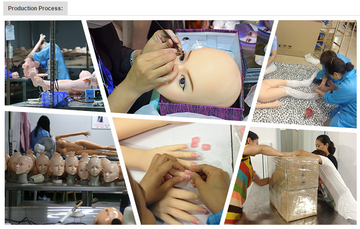Silicone dolls are cherished for their realistic appearance and durability, but accidental stains can mar their beauty. Whether it’s makeup, ink, or food spills, effective cleaning requires the right techniques to avoid damaging the material. Here’s a comprehensive guide to restoring your silicone doll’s pristine look, backed by expert insights and practical solutions.
Why Silicone Stains Happen
Silicone is a porous material that absorbs pigments over time, especially when exposed to:
• Dyes from clothing (dark colors like red or black) .
• Harsh chemicals (e.g., hair dyes or cleaning agents) .
• Environmental factors (UV exposure or humidity) .
Left untreated, stains can oxidize and become permanent. Act quickly to prevent long-term damage.
Step-by-Step Stain Removal Methods
1. Pre-Clean the Surface
• Wipe with mild soap and water: Use a soft cloth soaked in lukewarm water and pH-neutral soap to remove surface dirt. Avoid abrasive scrubbers to prevent scratches .
• Dry thoroughly: Pat the area with a microfiber towel to eliminate moisture, which can trap stains.
2. For Light Stains: Natural Solutions
• Baking soda paste: Mix baking soda with water to form a paste. Gently rub it into the stain for 5–10 minutes, then rinse. Ideal for grease or food residues .
• White vinegar solution: Dilute equal parts vinegar and water. Soak a cloth in the mixture and dab the stain. Vinegar breaks down organic pigments .
3. For Stubborn Stains: Targeted Treatments
• Hydrogen peroxide (3%): Dilute with water (1:5 ratio) and apply with a cotton swab. Let sit for 10–15 minutes before rinsing. Effective for ink or dark discoloration .
• Silicone-safe decolorizer: Products like TPE Silicone Doll Stain Remover penetrate deep layers to dissolve pigments. Apply, wrap in plastic wrap for 24–72 hours, and repeat as needed .
• Oxygen bleach (non-chlorine): Mix with warm water and soak the doll’s stained area for 24 hours. Rinse and dry thoroughly .
4. Avoid These Mistakes
• Acidic cleaners (vinegar in excess) or alkaline solutions can degrade silicone over time .
• Alcohol-based products may dry out the material, causing brittleness .
• Scrubbing too hard: Use gentle motions to protect the silicone’s surface integrity.
Preventative Tips for Long-Lasting Color
• Choose light-colored clothing: Dark outfits transfer pigments more easily .
• Seal with a protective spray: Silicone sealants can create a barrier against stains (test on a small area first).
• Regular maintenance: Clean your doll weekly with mild soap to prevent buildup .
FAQ: Common Stain Concerns
Q: Can I use bleach on silicone dolls?
A: Avoid chlorine bleach. It reacts with silicone, causing yellowing or cracking . Opt for oxygen-based alternatives.
Q: My stain won’t budge. What now?
A: For severe discoloration, consult a professional doll restoration service. Prolonged exposure to harsh chemicals may permanently damage the silicone .
Q: How often should I clean my doll?
A: Wipe down after each use, and deep-clean monthly to maintain hygiene and appearance .
Final Thoughts
With the right approach, silicone doll stains are manageable. Prioritize gentle, non-invasive methods to preserve your doll’s realistic texture and color. For recurring issues, invest in high-quality protective products to minimize future damage.
Ready to revive your silicone doll? Share your success stories in the comments below! 🌟




